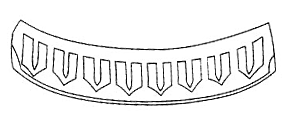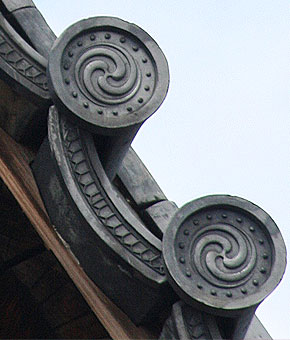|
||
 |
||


Houryuuji
Touin Shourou 法隆寺東院鐘楼 (Nara)

*kendomoe 剣巴
(C)2001 Japanese Architecture and Art Net Users System. No reproduction or republication without written permission.
掲載のテキスト・写真・イラストなど、全てのコンテンツの無断複製・転載を禁じます。
|
||||||
| kentoumon 剣頭文 | ||||||
| KEY WORD : architecture / roofing tiles | ||||||
| Lit.
sword tip motif. Also kentomoemon noki hiragawara 剣巴文軒平瓦. Also kenbishimon
剣菱文. The pendant *gatou
瓦当 of a broad, concave eave-end tile *nokihiragawara
軒平瓦 decorated with a row of stylized sword tips. Commonly used after the
middle of the Heian and well into the Kamakura period. Traces of an
imprint of cloth *nunomeato
布目痕 are evident on excavated examples suggesting that the entire pattern
was made simultaneously by pressing a cloth covered board with the carved
motif onto wet clay. A relatively wide undecorated rim remains between the
indented sword motif and the edge of the tile. The illustrated example shown
below was excavated from the site of Hosshouji 法勝寺 in Kyoto. This temple
was the first of the six temples called Rokushouji 六勝寺 and was built at
the request of Emperor Shirakawa 白河 (1072-86). It is known that the Kondou
金堂 and Koudou 講堂 of Hosshouji were dedicated in 1077. Another broad, concave
eave-end tile has a sword pattern and three comma patterns *tomoemon
巴文, one placed at each end and one at the center. It is called *kendomoe
剣巴. This pattern dates from the late 12c and was unearthed at the site
of Tachibanadera 橘寺 in Nara. The sword and comma motifs also became very popular
for decorating the borders of Buddhist altars *butsudan
仏壇 and ritual drums taiko 太鼓 at the end of the 12c. |
||||||
  Houryuuji
Touin Shourou 法隆寺東院鐘楼 (Nara)
 *kendomoe 剣巴
|
||||||
| REFERENCES: | ||||||
| EXTERNAL LINKS: | ||||||
| NOTES: | ||||||
(C)2001 Japanese Architecture and Art Net Users System. No reproduction or republication without written permission. 掲載のテキスト・写真・イラストなど、全てのコンテンツの無断複製・転載を禁じます。 |
||||||